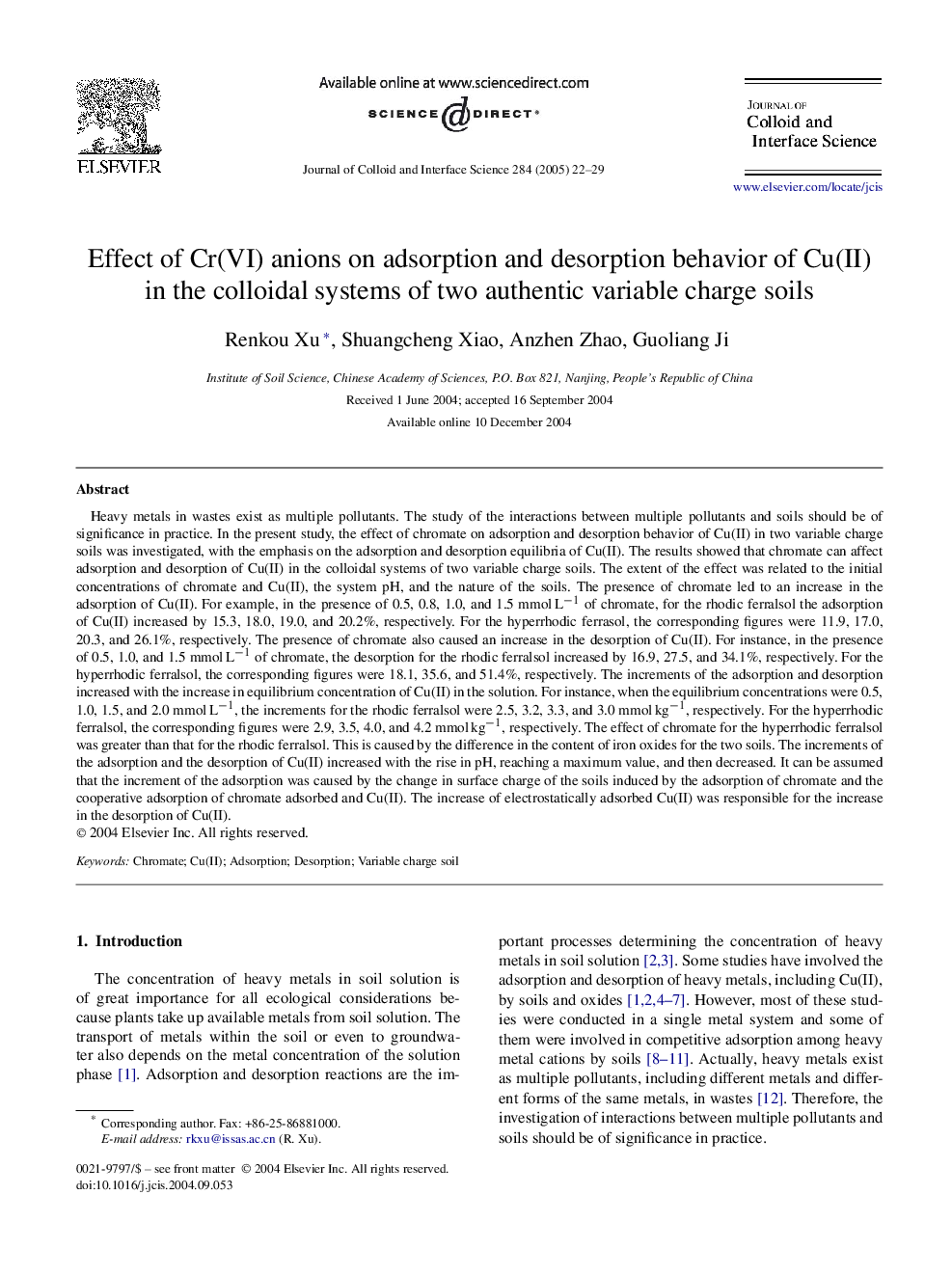| کد مقاله | کد نشریه | سال انتشار | مقاله انگلیسی | نسخه تمام متن |
|---|---|---|---|---|
| 10378129 | 880750 | 2005 | 8 صفحه PDF | دانلود رایگان |
عنوان انگلیسی مقاله ISI
Effect of Cr(VI) anions on adsorption and desorption behavior of Cu(II) in the colloidal systems of two authentic variable charge soils
دانلود مقاله + سفارش ترجمه
دانلود مقاله ISI انگلیسی
رایگان برای ایرانیان
کلمات کلیدی
موضوعات مرتبط
مهندسی و علوم پایه
مهندسی شیمی
شیمی کلوئیدی و سطحی
پیش نمایش صفحه اول مقاله

چکیده انگلیسی
Heavy metals in wastes exist as multiple pollutants. The study of the interactions between multiple pollutants and soils should be of significance in practice. In the present study, the effect of chromate on adsorption and desorption behavior of Cu(II) in two variable charge soils was investigated, with the emphasis on the adsorption and desorption equilibria of Cu(II). The results showed that chromate can affect adsorption and desorption of Cu(II) in the colloidal systems of two variable charge soils. The extent of the effect was related to the initial concentrations of chromate and Cu(II), the system pH, and the nature of the soils. The presence of chromate led to an increase in the adsorption of Cu(II). For example, in the presence of 0.5, 0.8, 1.0, and 1.5 mmolâLâ1 of chromate, for the rhodic ferralsol the adsorption of Cu(II) increased by 15.3, 18.0, 19.0, and 20.2%, respectively. For the hyperrhodic ferrasol, the corresponding figures were 11.9, 17.0, 20.3, and 26.1%, respectively. The presence of chromate also caused an increase in the desorption of Cu(II). For instance, in the presence of 0.5, 1.0, and 1.5 mmolâLâ1 of chromate, the desorption for the rhodic ferralsol increased by 16.9, 27.5, and 34.1%, respectively. For the hyperrhodic ferralsol, the corresponding figures were 18.1, 35.6, and 51.4%, respectively. The increments of the adsorption and desorption increased with the increase in equilibrium concentration of Cu(II) in the solution. For instance, when the equilibrium concentrations were 0.5, 1.0, 1.5, and 2.0 mmolâLâ1, the increments for the rhodic ferralsol were 2.5, 3.2, 3.3, and 3.0 mmolâkgâ1, respectively. For the hyperrhodic ferralsol, the corresponding figures were 2.9, 3.5, 4.0, and 4.2 mmolâkgâ1, respectively. The effect of chromate for the hyperrhodic ferralsol was greater than that for the rhodic ferralsol. This is caused by the difference in the content of iron oxides for the two soils. The increments of the adsorption and the desorption of Cu(II) increased with the rise in pH, reaching a maximum value, and then decreased. It can be assumed that the increment of the adsorption was caused by the change in surface charge of the soils induced by the adsorption of chromate and the cooperative adsorption of chromate adsorbed and Cu(II). The increase of electrostatically adsorbed Cu(II) was responsible for the increase in the desorption of Cu(II).
ناشر
Database: Elsevier - ScienceDirect (ساینس دایرکت)
Journal: Journal of Colloid and Interface Science - Volume 284, Issue 1, 1 April 2005, Pages 22-29
Journal: Journal of Colloid and Interface Science - Volume 284, Issue 1, 1 April 2005, Pages 22-29
نویسندگان
Renkou Xu, Shuangcheng Xiao, Anzhen Zhao, Guoliang Ji,